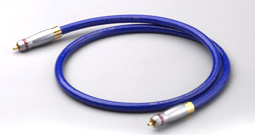You are reading the older HTML site
Positive Feedback ISSUE 2
august/september 2002
ensemble
DynaFlux cables
as reviewed by Larry Cox

LARRY COX'S SYSTEM: LOUDSPEAKERS ELECTRONICS SOURCE CABLES ACCESSORIES
|
I’m usually loathe to write reviews of cables. The differences, while audible, aren’t of the same order as those of, say, upgraded speakers. Spending more on speakers or an amplifier might be a better choice, at least for me. For the most part, I see upgrading interconnects and speaker cables as dotting "i’s" and crossing "t’s" in a system you are already content with, sort of like the finishing touches on an otherwise complete picture.
We recently reviewed Swiss manufacturer Ensemble’s MegaFlux FSF ($450/meter) interconnects and a handful of their other wire. The MegaFlux has a rich, full-bodied presentation, different from but competitive with the Nordost Quattro Fil ($1600/0.6 meters), which has been my reference wire for about three years. The Nordost is more revealing, detailed, and faster sounding than the Megaflux FSF, albeit at the cost of a slightly leaner and lighter-weight sound. The Nordost was the ultimate winner in my system, but the comparison was an intriguing look into value, as the MegaFlux cost about an eighth of the price of the Quattro Fil (remember, the Ensemble is one meter compared to a little more than half a meter of Nordost).
When Brian Ackerman, importer of things Ensemble, e-mailed me telling me that Ensemble’s new DynaFlux FSF interconnects were even better than the MegaFlux, my eyes glazed over at the prospect of listening to and writing about another set of wires by the same manufacturer just a few months later. The DynaFlux, at $850/meter, is Ensemble’s new top of the line, and quite a bit more expensive than the MegaFlux, but hardly in heart-attack territory, so I wasn’t sure whether the difference would be interesting, much less dramatic. I requested another set of MegaFlux interconnects along with the DynaFlux so that I could compare the two.
The short scoop is that the DynaFlux expands on and improves on every parameter of the already very good MegaFlux. The sound was at once fuller, more extended and more detailed, while retaining a relaxed and realistic tonality. I don’t mean they sounded flaccid, I mean they invited me to relax rather than listen like I was sitting on a broomstick. The additional $400/meter is actually a bargain. The DynaFlux is nearly custom-made cable. It is very, very well made, a demonstration of outstanding Swiss engineering. If you can swing the MegaFlux, you should work a couple of extra weekends, or do whatever you need to do to get yourself into DynaFlux territory. They are that much better.
Even the connectors are better. The RCAs on the MegaFlux use pressure to grab hold, while the DynaFlux’s RCAs are screw-on works of art. The screw-tight collars are both visually appealing, but they also allow the interface between wire and RCA jack to take stress off the welded connection, as the collars are unusually long.
Though the MegaFlux only started to really show its pedigree with my system entirely wired by Ensemble, the DynaFlux showed its pedigree immediately, with only one set of interconnects in place. Within a week, the DynaFlux established itself as a reference-quality interconnect in my system. It made every other component I had at home shine a little more elegantly, dynamically, and musically. Please know that both warts and beauty came through with the DynaFlux, but for some reason even the warts were revealed as warts on music, not on sound. The sonic aberrations of the recording seemed like a connected but not integral part of the recording, part of the soundscape but easily distinguished as separate from the music. This may the one cable you could stick it in almost any system and transport it to a new level of musicality. I’d still suggest getting most of your system established before indulging in these cables, but maybe, just maybe... Christmas time? Your birthday?
The DynaFlux knocked the Nordost Quattro Fils on their keester. The bottom end dropped maybe half an octave, while remaining tight, full, and fast. Timbre in the bottom end, long desired but too infrequently experienced in my system, locked into place. Images anchored themselves in my room, providing the experience of musicians settling in for a night of music. Standup bass was particularly excellent on Joe Williams’ "Every Day I Have the Blues," as well as on Yello’s "Oh, Yeah! and numerous other bottom-scraping tracks. The Dynafluxes were the sonic equivalent of a cappuccino to the Nordost Quattro Fil’s lighter, leaner latte. The Quattro Fils offer an excellent presentation of detail, and for me they are the best in the Nordost line by a substantial margin. The DynaFlux remained detailed while allowing the darker portion of bass to still transmit detail and texture, giving an extraordinary presentation of timbre without giving up any detail to the far more expensive Nordost.
Vocals, male and female, were something special, warm, liquid, full, and distinctly emanating from a liquid source (a human body!) while nuanced, sweet, and elegant, or throaty, harsh, and frightening as need be (e.g., Tom Waits). Brass had the bite, blat, and overwhelming sound that these instruments provide live. Imaging was first rate, and as good as any cable I’ve had in my system, at any time. The DynaFlux provided imaging normally associated with tube amplifiers, even though I’ve been listening with solid state amps. The Ensemble DynaFlux wire is extraordinary. If you are looking for the crowning element of your system, the DynaFlux could be it. Were I in a position to afford them, I’d certainly replace my Quattro Fils NOW. Best buy, recommended, go get ‘em! Larry Cox
Ensemble
web address: www.aaudio.co
